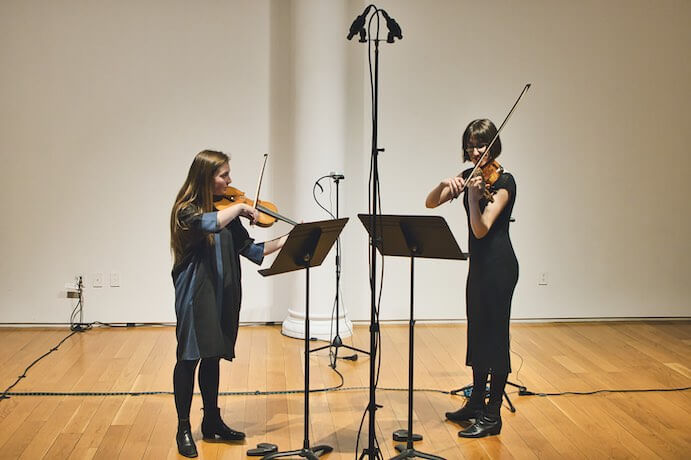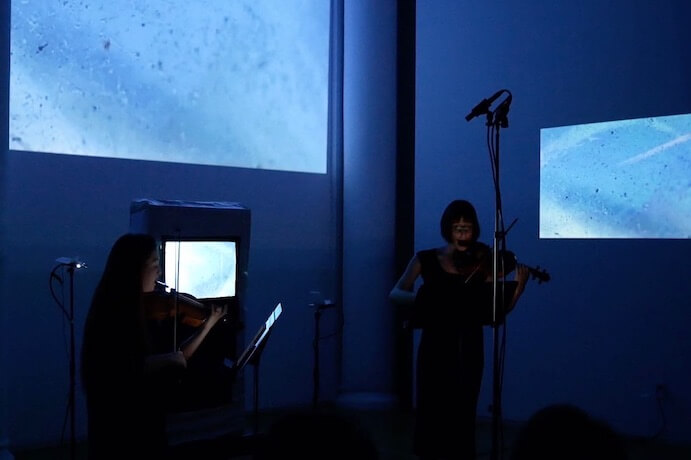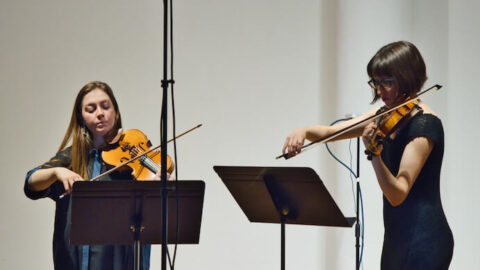Aimée Niemann and Charlotte Munn-Wood are the artists behind Du.0 (du-point-oh), a self-described feminist-gesamtkünstwerk-chamber-noise violin duo based in New York City. Their concert at Tenri Cultural Institute on Saturday, February 22, 2020 was entitled “3 to 7 Sounds,” though it’s safe to say there were far more sounds in the concert of works by Emily Praetorius, Leah Asher, and Scott Wollschleger—all of which were written for Du.0.
In welcoming the audience, which filled Tenri to standing-room-only capacity, Munn-Wood acknowledged that a violin duo might seem like strange instrumentation for an ensemble. Du.0’s mission is to generate a repertoire that has real depth and a sense of immediacy—a vision shared by other commission-focused New York ensembles with equally curious instrumentations, such as TAK Ensemble and Grand Band.
Emily Praetorius’ That It Was To Say (2017) opened with the two violinists invoking a sense of quiet vastness with long, sustained pitches. The players hummed with a breathy timbre not unlike the wispy, ethereal bowing of their instruments. Before they began playing, Munn-Wood stated that this work was intended to be heard from a very close proximity. From my seat in the front row, tiny sounds such as the unsticking of fingers on strings had a surprisingly dramatic effect. That It Was To Say is well paced, at once drawing the listener in with expansive, trancelike gestures and holding them there with the slow burn of gradually evolving sounds. Du.0 shone in moments of deep listening, where the music offered space for the players to shape and meld their individual sounds. The piece ended with Niemann and Munn-Wood gently cradling their instruments, bowing them in large, airy circles and softly cooing, as if to put them to sleep.

Leah Asher’s Upon the Wheel (2019) was one of two world premieres of the evening. Asher is a violinist herself, as well as a composer and visual artist. She is known for her works that feature graphic notations, a kind of alternative approach to notating music that gained traction in the 1950s but remains in vogue in certain creative circles today. Upon the Wheel is notated with a mix of graphic and conventional staff notation, but in listening to it, one is hard pressed to make the distinction. The most striking feature of Asher’s work is her keen ear for timbre, and this piece is no exception—this is some of the most deeply textured music out there. Upon the Wheel is broken up into subsections, often with short breaks between. One such section features droning hums and long-sung words of a text by Hildegard von Bingen, over which high violin partials tentatively squeak. Other sections are highly varied, with the rapid transfer of gestures inciting a riveting sense of urgency between the players. Asher invites listeners to explore timbral texture like a deep-sea crew explores a long-forgotten wreck; with probing curiosity and disciplined fervor.
For the final work of the program, also a world premiere, Du.0 welcomed a special guest to the stage—a four-foot-something rectangular prism that resembled an old iPod (chunky and monolithic with a half-screen). Crafted from styrofoam, an old shower curtain, and spray paint, it showed discoloration and damage from its journey thus far. To put it bluntly, it looked like trash. This strange artifact was not out of place, as Scott Wollschleger’s work Dead Horse Bay (Thoughts from the Future) (2019) is in many ways a piece about trash. Dead Horse Bay is a small body of water in between two inlets in south Brooklyn, and in the nineteenth and twentieth centuries, was many things: a glue factory (the periodic clogging of the bay with carcasses gave the bay its name), a landfill, and a failed land expansion by urban planner Robert Moses; today, it is managed by the National Park Service, and is visited by adventurous New Yorkers on the hunt for relics from the past, as well as curious composers.

Wollschleger’s work features video taken at Dead Horse Bay, which was projected onto the walls of Tenri in three places, and onto the iPod sculpture positioned between the players. Musically, the work is a grab bag of motives that vary from dissonant and fluttering to rapidly hocketing to childlike and simple. The form of this work mirrors the visual aesthetic of Dead Horse Bay, with musical objects strewn about in a recurring and haphazard way, similar to the bottles, chairs, bones, and seaweed embedded in the bay. The video component to the piece provided nice visuals, but the coordination of music and image often felt lackluster rather than complementary. Overall, Wollschleger succeeded in creating a hypnotic and surreal exploration of the artifacts and atmosphere at Dead Horse Bay. His music and visuals hint at the vestiges of humanity that cling to these objects like rust and decay, and leave us with two lingering, haunting questions: how did these objects get here, and to whom did these objects belong?
At the conclusion of the program, the players encouraged people to mingle and enjoy the two bottles of wine they brought. The audience looked around and let out a hearty laugh, as two bottles obviously wouldn’t make it very far given the huge turnout. Through their successful crowd funding commissioning efforts, community engagement, and enthusiastic audience, Du.0 demonstrates that lively support for an unconventional ensemble is not a relic of the past.
























